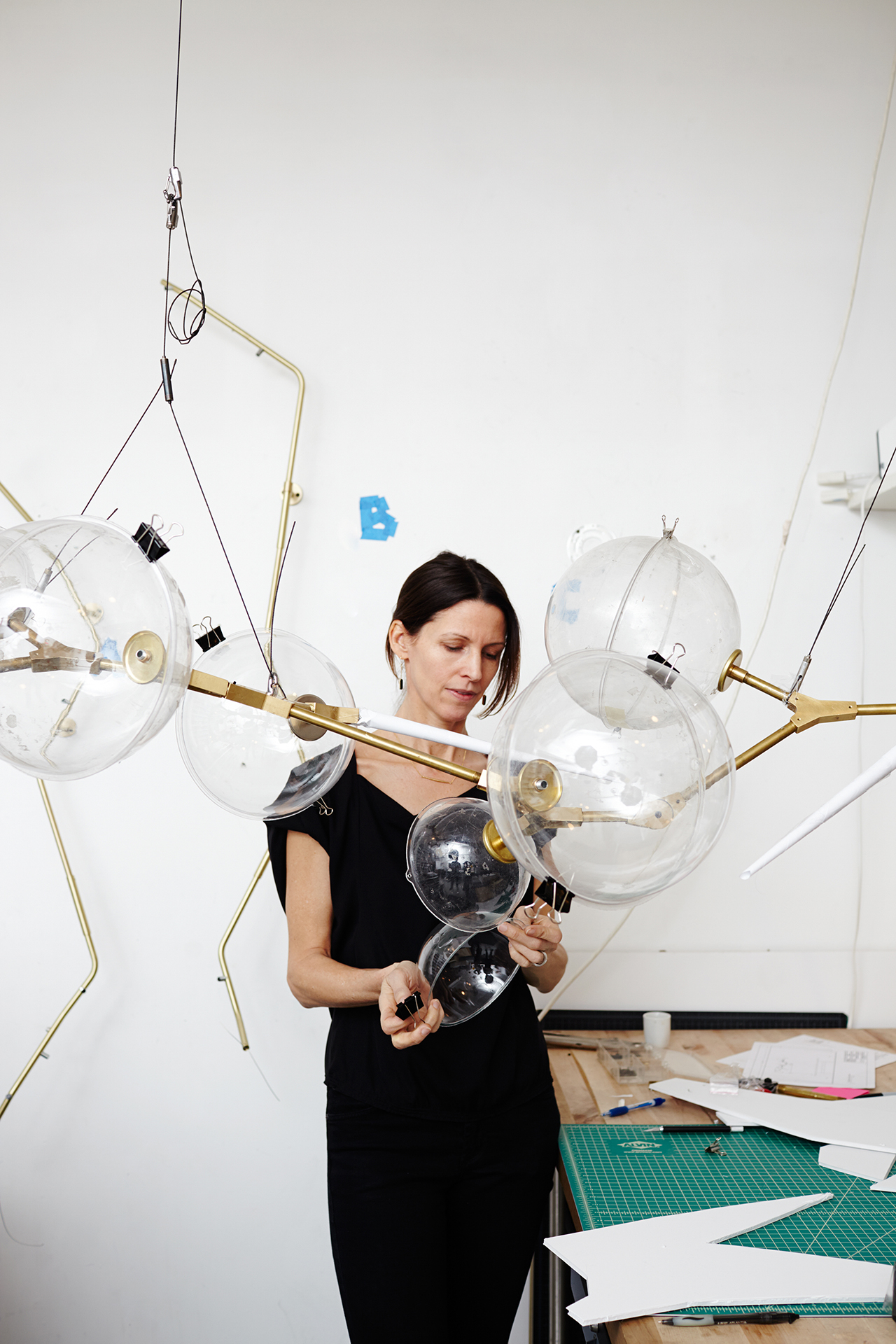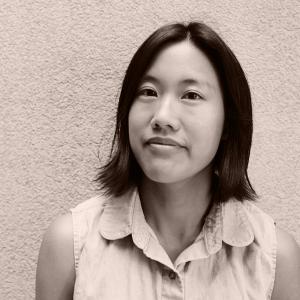Lindsey Adelman’s collaborative, creative universe.
Nature & Nurture
-
Image © Winnie Au for L'AB/Pamono
-
Image © Winnie Au for L'AB/Pamono
-
Image © Winnie Au for L'AB/Pamono
-
Image © Winnie Au for L'AB/Pamono
-
Image © Winnie Au for L'AB/Pamono
-
Adelman's team at work in the studio
Image © Winnie Au for L'AB/Pamono
-
Image © Winnie Au for L'AB/Pamono
-
Image © Winnie Au for L'AB/Pamono
-
Image © Winnie Au for L'AB/Pamono
-
Wave Hill's inspiring green house
Image © Winnie Au for L'AB/Pamono
-
Lindsey Adelman in the cactus and succulent house
Image © Winnie Au for L'AB/Pamono
-
Image © Winnie Au for L'AB/Pamono
-
Image © Winnie Au for L'AB/Pamono
-
The tropical house
Image © Winnie Au for L'AB/Pamono
-
Image © Winnie Au for L'AB/Pamono
-
Image © Winnie Au for L'AB/Pamono
-
Image © Winnie Au for L'AB/Pamono
-
Image © Winnie Au for L'AB/Pamono
These days, in almost any conversation one has about the New York design scene, the name Lindsey Adelman is bound to come up. And rightly so. Adelman opened her Manhattan lighting design studio in 2006, and since that time, her practice has grown exponentially. Today, she oversees a team of twenty, which designs, prototypes, and builds each light to order in-house (working with local brass and glass-blowing manufacturers to develop custom parts). She exhibits her work both domestically and abroad at top tier spaces such as BDDW in New York, Nilufar in Milan, and Carwan Gallery in Beirut. Adelman is, without question, one of the key faces of not just New York design, but American industrial design today.
Adelman’s carved out her own space in the scene with sculptural lighting and objects that juxtapose nature-inspired shapes and structures with machine-made, metal elements. The resulting designs—ranging from chandeliers, sconces, and candelabras to jewelry and accessories—are composed of strong lines and soft curves. They are at once beautifully poised and slightly quirky; delicate and fluid with an industrial edge. Sometimes, such as with the aptly titled Branching and Terrarium collections, Adelman’s pieces seem resolute and complete, calling to mind the limbs and blooms of flowering trees. Others series, like the poppy, punctuated Cherrybomb or the milky, drippy Catch, offer a sense of movement even as the work stands still; glass seems almost to melt or burst before us. To hear Adelman tell it, “I try to combine robust materials and joints and straight lines and turn them into something that undulates.”
Adelman’s team produces approximately seventy chandeliers to order each month; her sizable studio, presently spread across two neighboring buildings, is packed with humming work benches and materials, shelf-to-shelf with carefully labeled trays containing various supplies—myriad screws and rods and cords and bulbs—all ready for assembly. Adelman’s online customers select the design they’re interested in, as well as, in some cases, the hand finishing they prefer. Then they can either order the finished piece or—for the handier among us—one of Adelman’s You Make It pieces, which arrives as a kit with standard industry parts and instructions for putting the design together at home. These objects encourage Adelman’s clients to experiment on their own. As her website reads, “Experimenting with off-the-shelf parts is how Lindsey got started . . .”
While Adelman’s studio vibe is incredibly energetic and collaborative, it’s also clear that her pieces are inspired by very personal, quiet moments. “I find inspiration in ugly, frustrating things as well as in moments that feel free, open, and wild,” she says. The former English major cites everything from a “gorgeous pile of sticks” to more urban instances of “tangled electrical cords or even something hanging from a garbage can” as stimuli for her creativity.
The designer points specifically to Wave Hill, a serene, 28-acre public garden and cultural center overlooking the Hudson River north of Manhattan, just a short jaunt from the last stop on the 1 train, as one of her go-to locations for inspiration. “It is such a special spot to get lost in nature in the middle of the Bronx,” she says. As we walked together earlier this month through Wave Hill’s flower garden to the conservatory, flanked by newly blooming cherry trees, it was a pleasure to watch Adelman take it all in. Inside the greenhouse, we found lush local and tropical flora—palms and succulents and cacti in myriad shapes, colors, and sizes—all providing clear fodder for the imagination, and echoing again and again the organic forms one encounters in Adelman’s work.
Describing her design process, she says, “When I work out the structures—for example, if I have nine points of light, and I want to spread them out to hang over a dining table using the least amount of material—as we develop the joints and the tubes and the leverage, you always realize, oh, right, nature’s already figured it out. It’s always the exact same angles in molecules or the exact same angles in the veins of a leaf or cracks in clay.”
Back at Adelman’s bustling studio, colleagues are plugging away at various workstations—constructing chandeliers and prototypes, assembling sockets and the like in pre-production—to bring her imagination to life. The space is a well-run ship—checklists and instructional diagrams abound, and Adelman continually refers to a printed daily schedule as we walk around. At the same time, creativity and exploration are steadfastly encouraged in Adelman’s world. In fact, the day of my visit turned out to be the studio’s very first “Dev Day,” a newly introduced program that allows the team to focus on something besides client-directed work. “We created Development Day to clear space for the projects that need attention and time without production going on at the same time. Interesting ideas get pushed to the next level on these days, and others get weeded out,” Adelman says.
While also preparing for presentations for both Salone del Mobile in Milan and New York Design Week (in addition to the usual monthly orders), the crew was making time to work on elements for a music video; one of a few in-house, clientless projects they’ve collaborated on for purely creative motives. “Laura Young, our director of operations, is an amazing singer, so she’s written a song and will sing,” Adelman explains. “Leo Madriz, who builds chandeliers, is also a musician, so he recorded environmental sounds in the metal shop, and he’s mixed music into it. The team over there is making jewelry for it.”
She continues, “I look at these projects as pure freedom. We try to get a handle on the outside world directing us; we have to carve out time to direct our own work. I’m pretty aggressive about it, actually,” she says, smiling. And later, “Dance practice is Friday.”
She believes these two sides of the business really feed into one another. ”We must have a solid foundation of building standard models we believe in, and it also gives us structure. Then we can create this downtime—space to experiment, try things, fail, make a mess. I would never want only one or the other.”
Adelman goes on, “Everyone here is so creative, and it just allows them to take more ownership in their jobs—and not get bored or stifled. People can work together from different departments. It takes a lot of self-discipline on everybody’s part to get all our work done, because the client work is due when it’s due, but I don’t have to worry about that; everyone is so conscientious here.”
In addition to Dev Day, Adelman encourages both creative independence and teambuilding by offering each member of her crew a one-week-long sponsored retreat of his or her choosing every year. “One is going to Boisbuchet in the south of France this summer; one is taking the D-Crit [Design Criticism] workshop at SVA [the School of Visual Arts]; we’ve had employees do canoe-building in New Hampshire, leather-working in San Francisco, weaving in Virginia, and neon lighting in Iceland. They prepare a presentation to the whole studio when they return. I think we all find it very inspiring and edifying.”
Recently, Colin Cobb, a member of the studio’s production team, presented the fruits of his chosen workshop—a course in improv with the nearby, much-lauded Upright Citizens Brigade. “He learned so much from that workshop that’s relevant to what we do,” Adelman notes. “One thing that really stuck in my mind is about working in groups. In improv, to keep each other going, one person says something and the other person responds with ‘Yes, and,’ which keeps the process moving forward. They experimented with alternative transitions, starting out by saying ‘No, but,’ and then ‘Yes, but,’ and then finally ‘Yes, and,’ which really kept the flow going. And that’s exactly what needs to happen within a design studio, or even with a client. We don’t always agree, but you have to keep the conversation going. It just feels good, frankly, to have the space to be able to make those things happen.”
Clearly, Adelman’s not just adept at finding inspiration in the world around her; she’s also keenly cultivating it within her day-to-day environment. Asked about balancing the process of individual creativity and focus and a collaborative environment for herself, Adelman says that for her, "the process of individual creativity has changed. I used to get antsy during team meetings, anxious to get into my own room and think straight. Now I find I am able to push ideas during meetings. Perhaps it comes down to being comfortable with vulnerability in front of others. I dearly trust my talented team and a big part of that is knowing they will not judge me. To arrive at a good idea you have to be able to blurt out a lot of bad ones. To say a lot of things out loud, realize what has been done before, what is pretentious, what is not innovative. After that you can get into a groove that is pure.”
-
Text by
-
Anna Carnick
Anna is Pamono’s Managing Editor. Her writing has appeared in several arts and culture publications, and she's edited over 20 books. Anna loves celebrating great artists, and seriously enjoys a good picnic.
-
-
Images by
-
Winnie Au
Winnie is an NYC-based portrait, fashion, and animal photographer. She recently published her first book, Canine Chronicles. She loves mac and cheese, bicycles, french pressed coffee, corgis, houseboats, and horror movies.
-



















 Lindsey Adelman working on a Branching chandelier
© Winnie Au for L'AB/Pamono
Lindsey Adelman working on a Branching chandelier
© Winnie Au for L'AB/Pamono
 A succulent plant at the Wave Hill green house
Winnie Au for L'AB/Pamono
A succulent plant at the Wave Hill green house
Winnie Au for L'AB/Pamono
 Lindsey and her team at the studio
© Winnie Au for L'AB/Pamono
Lindsey and her team at the studio
© Winnie Au for L'AB/Pamono
 Work materials at Adelman's studio
© Winnie Au for L'AB/Pamono
Work materials at Adelman's studio
© Winnie Au for L'AB/Pamono
 Colin Cobb
© Winnie Au for L'AB/Pamono
Colin Cobb
© Winnie Au for L'AB/Pamono

